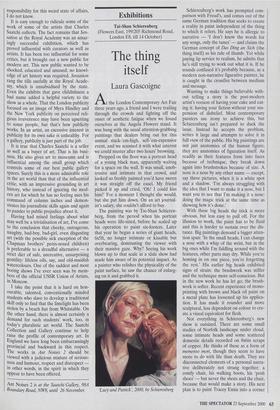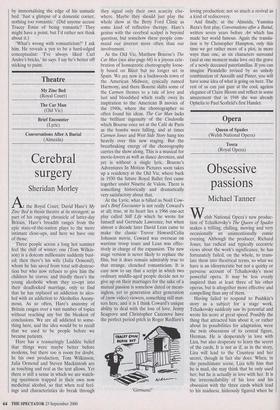Exhibitions
Tai-Shan Schierenberg (Flowers East, 199/205 Richmond Road, London E8, till 14 October)
The thing itself
Laura Gascoigne
At the London Contemporary Art Fair three years ago, a friend and I were trailing through the crowds and fighting off the onset of aesthetic fatigue when we found ourselves at the Angela Flowers stand. It was hung with the usual attention-grabbing paintings that dealers bring out for this annual stack-'em-high, sell-'em-expensive event, and we scanned it with what interest we could muster after two hours' browsing.
Propped on the floor was a portrait head of a young black man, apparently waiting for a space on the wall. It was small, unob- trusive and intimate in that crowd, and looked so freshly painted you'd have sworn it was straight off the easel. My friend picked it up and cried, 'Oh! I could kiss him!' For a moment I thought she would, but she put him down. On an art journal- ist's salary, she couldn't afford to buy.
The painting was by Tai-Shan Schieren- berg, from the period when his portrait heads were life-sized, before he scaled up his operation to paint six-footers. Later that year he began a series of giant heads, 6x5ft, no longer intimate or kissable but overbearing, dominating the viewer with their massive gaze. Why? Seeing his work blown up to that scale at a slide show had made him aware of its potential impact. As a painter who relishes the physicality of the paint surface, he saw the chance of enlarg- ing on it and grabbed it.
`Lucy and Patrick, 2000, by Schierenberg Schierenberg's work has prompted com- parison with Freud's, and comes out of the same German tradition that seeks to create a reality in paint independent of the thing to which it refers. He says he is allergic to narrative — 'I don't know the words for any songs, only the tunes' — and claims the German concept of Das Ding an Sich (the thing itself) as his rule of thumb. Yet while paying lip service to realism, he admits that he's still trying to work out what it is. If he sounds confused it's probably because, as a modern non-narrative figurative painter, he is caught in the crossfire between medium and message.
Wanting to make things believable with- out telling a story is the post-modern artist's version of having your cake and eat- ing it: having your fiction without your sus- pension of disbelief. Most contemporary painters use irony to achieve this, but Schierenberg isn't prepared to duck the issue. Instead he accepts the problem, writes it large and attempts to solve it in full view of the public. His big paintings are not just anatomies of the human figure; they are anatomies of figuration itself. As readily as their features form into faces because of technique, they break down again into brushstrokes because of size. A nose is a nose by any other name — except, say these pictures, when it is a white spot and a shadow. 'I'm always struggling with the idea that I want to make it a nose, but I want you to see that I'm making it a nose: doing the magic trick at the same time as showing how it's done.'
With these big heads the trick is more obvious, but less easy to pull off. For the illusion to work, the paint has to be fluid and this is harder to sustain over the dis- tance. Big paintings demand a bigger atten- tion span: 'In the small heads, I can change a nose with a whip of the wrist, but in the big ones while I'm fiddling around with the features, other parts may dry. While you're homing in on one piece, you're forgetting the rest.' His earlier big heads exhibited signs of strain: the brushwork was stiffer and the technique more self-conscious. But in the new work he has let go; the brush- work is softer. Recent experience of mono- printing with brown and black oil paint on a metal plate has loosened up his applica- tion. It has made it rounder and more sculptural, less dependent on colour to cre- ate a visual equivalent for flesh.
Not everything in Schierenberg's new show is outsized. There are some small studies of Norfolk landscape under cloud, some intimate heads and some scattered domestic details recorded on 8x6in scraps of copper. He thinks of these as a form of memento mod, though they seem to have more to do with life than death. They are disconnected elements of a personal narra- tive deliberately not strung together: a comfy chair, his walking boots, his 'posh shoes' -- but never the shoes and the chair, because that would make a story. His next plan is to paint Tracey Emin into a corner by immortalising the edge of his unmade bed: 'Just a glimpse of a domestic corner, nothing too romantic.' (Did anyone accuse Tracey Emin of being romantic? They might have a point, but I'd rather not think about it.) `What's wrong with romanticism?' I ask him. He reveals a yen to be a hard-edged conceptualist: 'I've always liked Carl Andre's bricks,' he says. I say he's better off sticking to paint.























































































 Previous page
Previous page